This article explains how to install Matomo Analytics with Nginx on Ubuntu 24.04.
Matomo Analytics is a powerful open-source web analytics platform that provides detailed insights into website visitors’ behavior. By installing Matomo Analytics with Nginx on Ubuntu, you can leverage Nginx’s performance and reliability as a web server and benefit from Matomo’s robust analytics features.
This winning combination allows you to closely monitor and analyze your website’s traffic, user engagement, and other vital metrics with utmost security and efficiency.
Furthermore, as the web server, Nginx optimizes the performance of Matomo Analytics, ensuring your analytics platform operates smoothly and effectively and giving you the confidence of a secure and reliable system.
The steps below walk you through installing Matomo Analytics with Nginx on Ubuntu 24.04.
Install Nginx HTTP server on Ubuntu
Matomo requires a web server. This post will install and use the Nginx web server to run Matomo.
To do that, open the Ubuntu terminal and run the commands below to install the Nginx web server.
sudo apt update
sudo apt install nginx
Once Nginx is installed, the commands below can start, stop, and enable the Nginx web server to start automatically when your server boots up.
sudo systemctl stop nginx
sudo systemctl start nginx
sudo systemctl enable nginx
You can test the Nginx web server by opening your web browser and browsing to the server’s localhost or IP address.
http://localhost
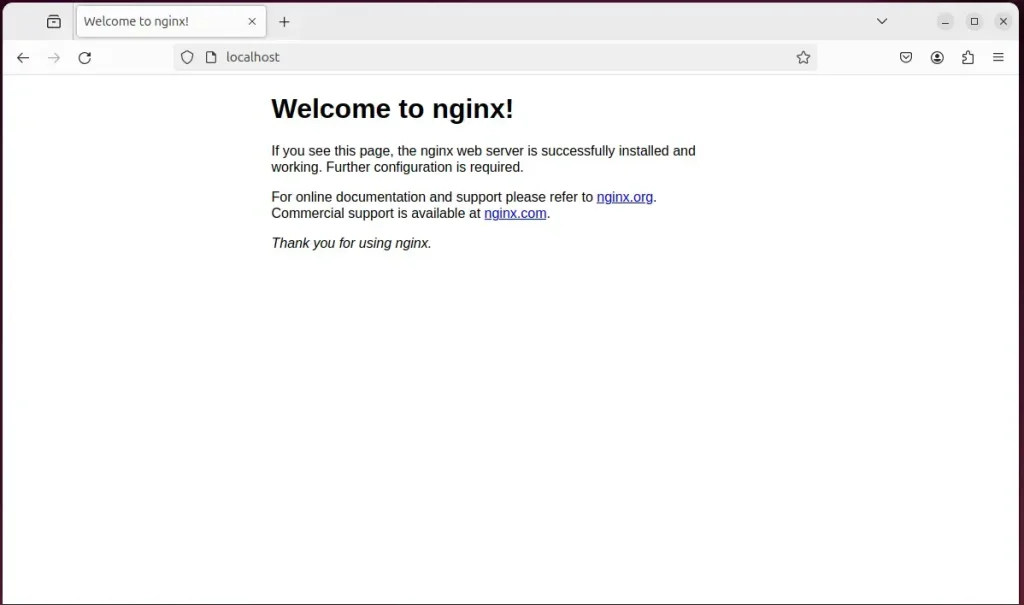
When you see the Welcome to nginx! page, it means the Nginx HTTP server is successfully installed.
Additional help on installing Nginx on Ubuntu is in the link below.
How to install Nginx on Ubuntu
Install the MariaDB database server on Ubuntu
The next component required to run Matomo is a database server. This post will install and use the MariaDB database server.
To install and use the MariaDB database server, use the instructions below.
Open the Ubuntu terminal and run the commands below to install the MariaDB database server.
sudo apt update sudo apt install mariadb-server
Once the MariaDB database server is installed, use the commands below to stop, start, and enable the MariaDB server to start automatically when the server boots.
sudo systemctl stop mariadb sudo systemctl start mariadb sudo systemctl enable mariadb
Run the following commands to validate and test if the MariaDB database server is installed successfully.
sudo mariadb
Once you run the commands above, it will log you onto the MariaDB console and display a message similar to the one below.
Welcome to the MariaDB monitor. Commands end with ; or \g. Your MariaDB connection id is 32 Server version: 10.11.2-MariaDB-1 Ubuntu 23.04 Copyright (c) 2000, 2018, Oracle, MariaDB Corporation Ab and others. Type 'help;' or '\h' for help. Type '\c' to clear the current input statement. MariaDB [(none)]>
The message tells you that the server is installed successfully.
Additional help on installing MariaDB.
Create a Matomo database
Upon successfully installing the MariaDB database server, create a blank database on the server specifically for the Matomo application.
As part of the setup, we will create a matomodb database and a user account called matomodbuser.
Finally, we’ll grant the matomodbuser full access to the matomodb database.
All the database steps above can be done using the commands below:
But first, log on to the MariaDB database server:
sudo mariadb
Then run the commands below to complete the steps:
CREATE DATABASE matomodb CHARACTER SET utf8mb4 COLLATE utf8mb4_general_ci;
CREATE USER matomodbuser@localhost IDENTIFIED BY 'type_your_password_here';
GRANT ALL ON matomodb.* TO matomodbuser@localhost WITH GRANT OPTION;
FLUSH PRIVILEGES;
exit
Ensure to replace ‘type_your_password_here ‘with your password.
Install PHP-FPM on Ubuntu Linux
The last component you will need to run Matomo is PHP-FPM. The Matomo application is PHP-based and supports the latest versions of PHP-FPM.
Run the commands below to install PHP-FPM.
sudo apt install php-fpm php-intl php-mysql php-curl php-cli php-zip php-xml php-gd php-common php-mbstring php-xmlrpc php-json php-sqlite3 php-soap php-ldap php-zip
Additional help on installing PHP
How to install PHP on Ubuntu Linux
Download Matomo files
Let’s begin downloading and configuring the Matomo files on Ubuntu Linux.
To always install the latest version, check the Matomo’s download page. If a new version is available, replace the version number in the link below.
First, navigate to the /tmp/ directory and download Matomo files. After unzipping the file, move the content into the Matomo folder in the Nginx root directory.
The final step is to change the permissions. This will allow the Nginx web server to interact safely with the files, ensuring a secure environment for your Matomo installation.
cd /tmp
wget https://builds.matomo.org/matomo-latest.zip
sudo unzip matomo-latest.zip -d /var/www/
sudo chown -R www-data:www-data /var/www/matomo
Once you have completed all the above steps, continue configuring the Nginx web server below to serve the Matomo content.
Run the commands below to create a Nginx server block file for Matomo.
sudo nano /etc/nginx/sites-available/matomo.conf
Then, copy and paste the content block below into the Nginx server block.
server {
listen 80;
listen [::]:80;
root /var/www/matomo;
index index.php;
server_name matomo.example.com;
location / {
try_files $uri $uri/ =404;
}
location ~ \.php$ {
include snippets/fastcgi-php.conf;
fastcgi_pass unix:/var/run/php/php8.3-fpm.sock;
fastcgi_param SCRIPT_FILENAME $document_root$fastcgi_script_name;
include fastcgi_params;
}
location ~ js/container_.*_preview\.js$ {
expires off;
add_header Cache-Control 'private, no-cache, no-store';
}
## deny access to all other .php files
location ~* ^.+\.php$ {
deny all;
return 403;
}
}
Save the file.
Then, run the commands below to enable the virtual host and restart the Nginx server.
sudo ln -s /etc/nginx/sites-available/matomo.conf /etc/nginx/sites-enabled/
sudo systemctl restart nginx.service
Setup Let’s Encrypt SSL/TLS for Matomo
You may want to install an SSL/TLS certificate to secure your Matomo site. Secure your Matomo installation with HTTPS from Let’s Encrypt.
Please read the post below for additional resources on installing and creating Let’s Encrypt SSL certificates for Nginx.
How to set up Let’s Encrypt SSL certificate for Nginx on Ubuntu Linux
Once you have restarted the Nginx web server, open your browser and browse to the server hostname or IP address defined in the Nginx server block.
http://matomo.example.com
A Matomo installation wizard page should appear. Next to begin.
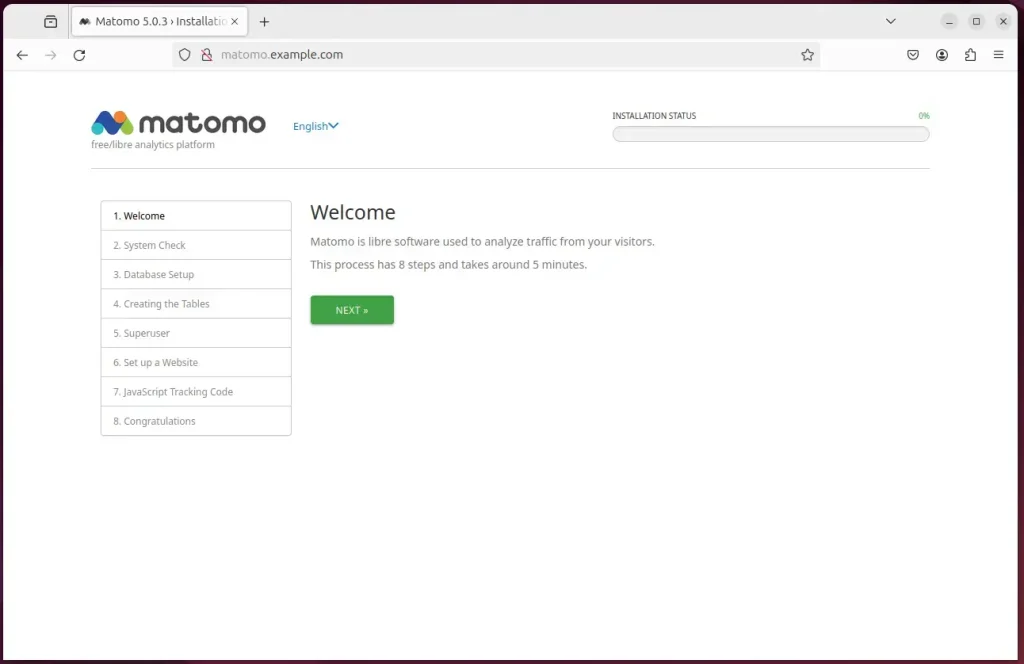
On the next page, confirm all requirements are met, then continue.
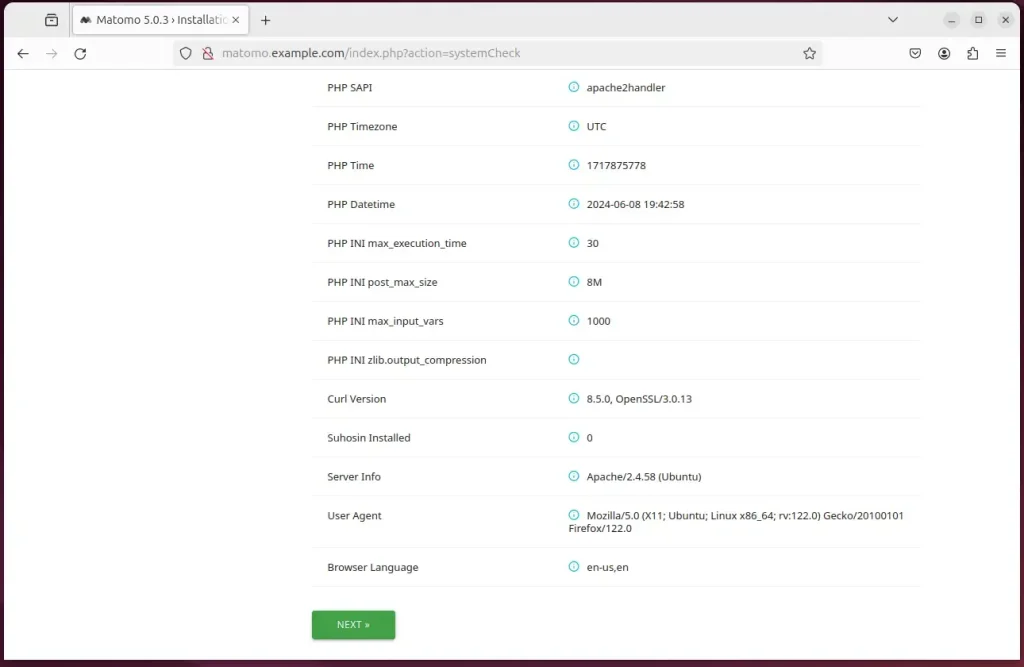
Next, enter the database name, account, and password and continue.
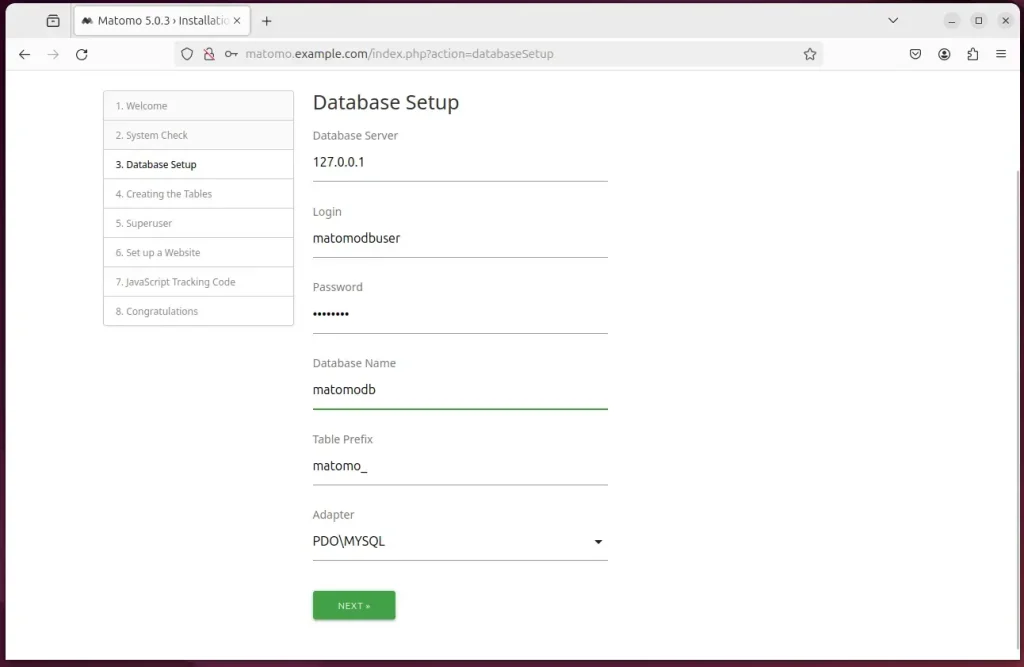
Next, create an admin account and continue.
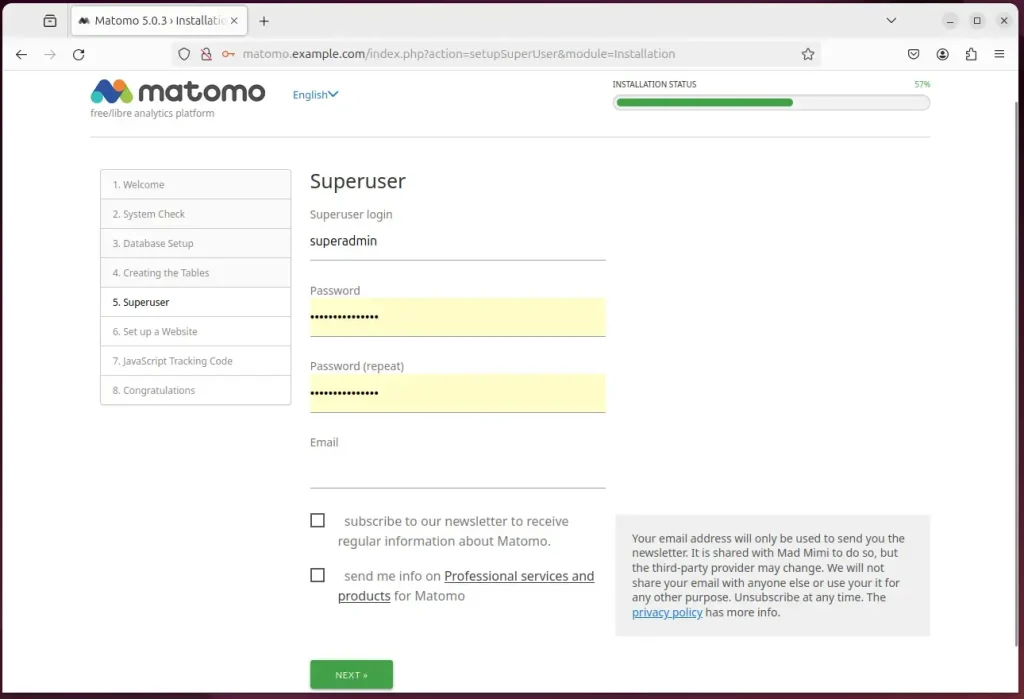
On the next screen, type in your site details and continue
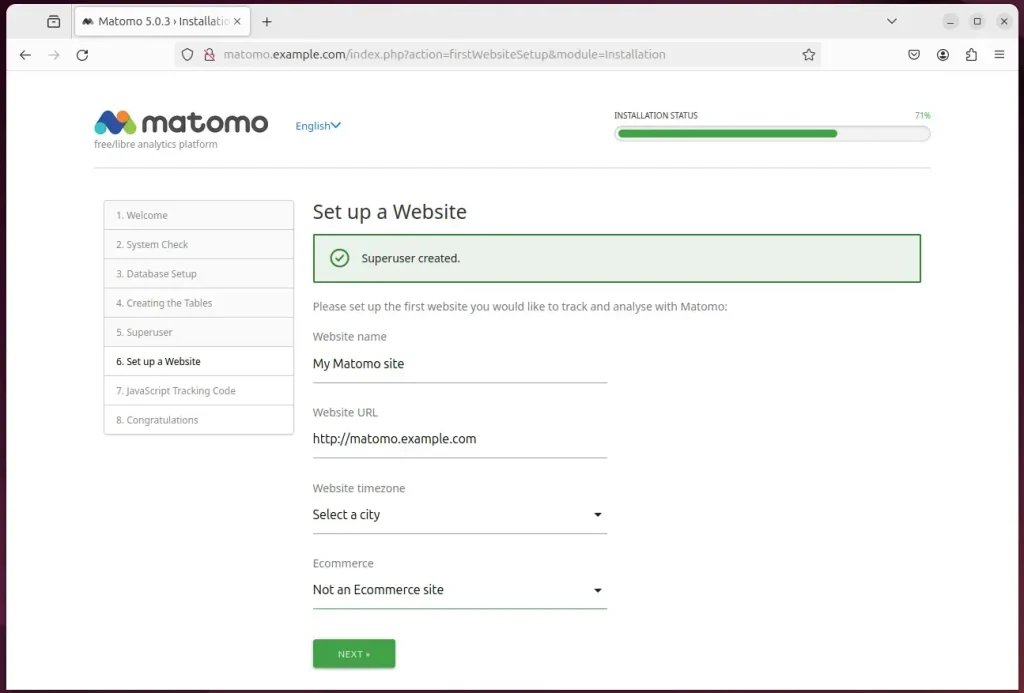
Copy the JavaScript code if you’d like and continue.
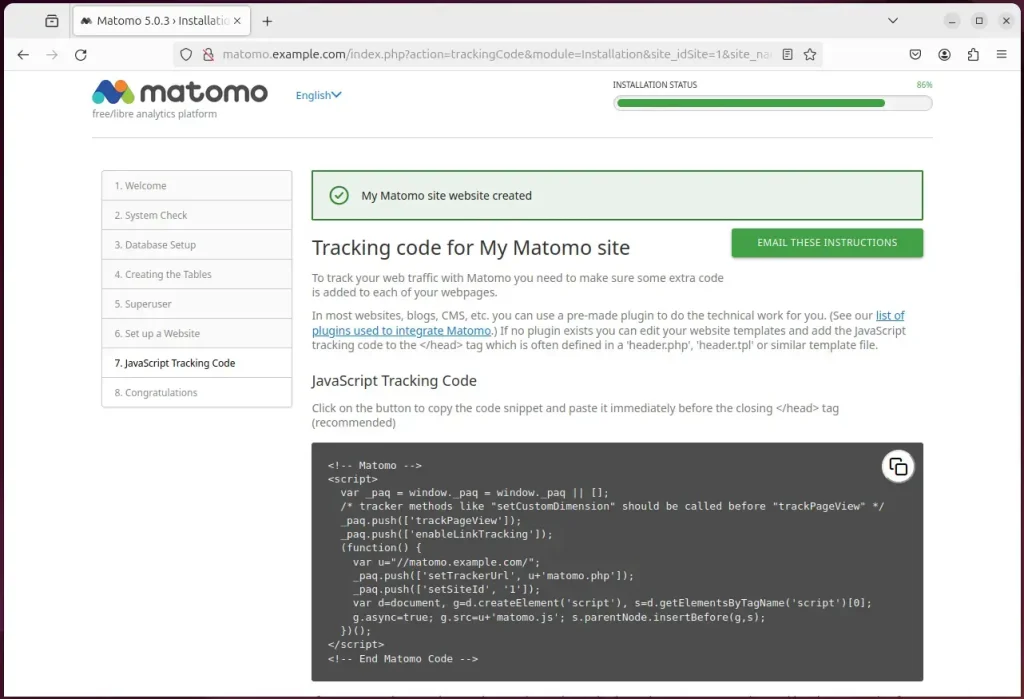
Your Matomo site should be set up and ready to use.
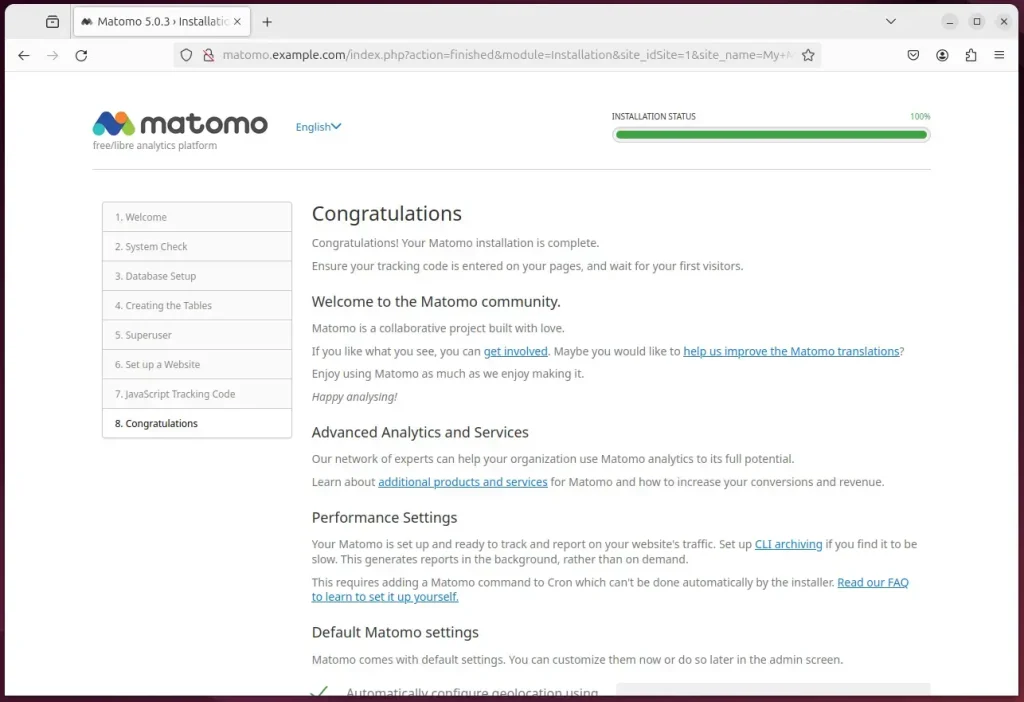
That should do it!
Conclusion:
- Matomo Analytics offers powerful open-source web analytics features for detailed insights into website visitor behavior.
- Installing Matomo Analytics with Nginx on Ubuntu 24.04 leverages the performance and reliability of Nginx as a web server, along with Matomo’s robust analytics capabilities.
- This combination allows for comprehensive monitoring and analysis of website traffic, user engagement, and other vital metrics with utmost security and efficiency.
- Nginx optimizes Matomo Analytics’ performance, ensuring the analytics platform’s smooth and effective operation within a secure and reliable system.
- Following the step-by-step guide, users can install Matomo Analytics with Nginx on Ubuntu 24.04 and set up a secure and efficient web analytics environment.

Leave a Reply